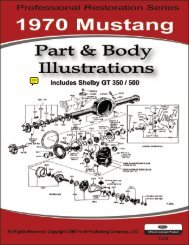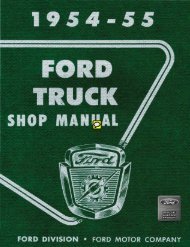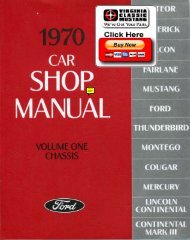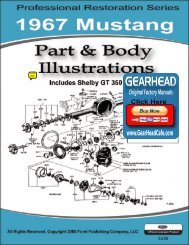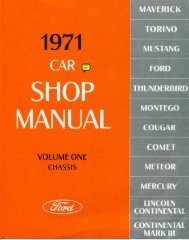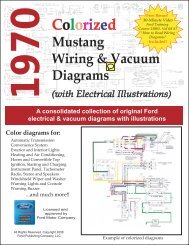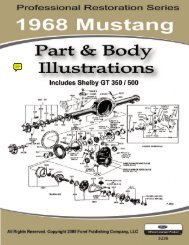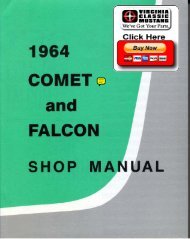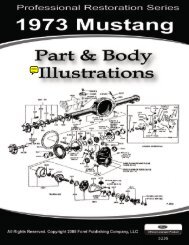DEMO - 1965 Ford Truck Shop Manual - ForelPublishing.com
DEMO - 1965 Ford Truck Shop Manual - ForelPublishing.com
DEMO - 1965 Ford Truck Shop Manual - ForelPublishing.com
You also want an ePaper? Increase the reach of your titles
YUMPU automatically turns print PDFs into web optimized ePapers that Google loves.
2-46 GROUP 2 - BRAKES<br />
FILTER<br />
RETAINER V<br />
fj<br />
H1336-A<br />
FIG. 18—Removing Diaphragm<br />
shell with a punch or screwdriver<br />
(Fig. 15). Discard the seal.<br />
14. Working from the inside of<br />
the front shell, cut the bead off the<br />
check valve grommet. Remove the<br />
check valve.<br />
FIG. 19—Removing Valve<br />
Retainer<br />
PUSH ROD<br />
FILTER RETAINER<br />
SLOT<br />
H 1337-A<br />
ASSEMBLY<br />
1. Place the rear shell on two wood<br />
blocks as shown in Fig. 20. Press a<br />
new seal, plastic side first, into the<br />
recess on the inside of the shell to a<br />
depth of VA inch.<br />
2. Dip a new check valve grommet<br />
(Fig. 15) in alcohol and install it in<br />
the front shell making sure that the<br />
beveled edge is toward the inside.<br />
Make sure that the grommet is seated.<br />
Dip the shoulder of the check<br />
valve in alcohol and install it in the<br />
grommet. Press check valve into<br />
grommet until the flange contacts<br />
the grommet.<br />
3. Apply silicone grease to the<br />
outer surface of the diaphragm plate<br />
hub and to the bearing and rubber<br />
surfaces of the valve.<br />
4. Insert the valve and rod into<br />
the hub of the diaphragm plate. Push<br />
the rod inward until the retaining<br />
groove is aligned with the slot, and<br />
then slide the retainer into the groove<br />
(Fig. 19).<br />
5. Tuck the filter into place in the<br />
plate hub. Press the filter retainer<br />
onto the hub being careful not to<br />
chip or damage the plastic (Fig. 18).<br />
6. Install the diaphragm on the<br />
diaphragm plate, making sure that<br />
the diaphragm lip is tucked in all<br />
around the recess between the hub<br />
and plate (Fig. 19).<br />
7. Place the rear shell in a vise.<br />
Apply silicone lubricant generously<br />
to the top outer flange of the shell.<br />
Apply silicone grease to the seal in<br />
the rear shell.<br />
8. Carefully guide the valve rod<br />
and diaphragm plate hub through the<br />
seal in the rear shell.<br />
9. Center the large end of the return<br />
spring on the diaphragm plate.<br />
10. Align the index mark on the<br />
front shell with the one on the rear<br />
shell. Place a flat bar on the front<br />
shell and <strong>com</strong>press the spring until<br />
the tangs on the rear shell contact<br />
the notched sections of the front<br />
shell, and then rotate it clockwise to<br />
lock it in place.<br />
11. Apply lubricant sparingly to<br />
the stem of the hydraulic push rod<br />
keeping it away from the adjusting<br />
screw area. Apply silicoite grease<br />
liberally to the piston area of the<br />
push rod and to the reaction disc.<br />
12. Center the reaction disc on the<br />
push rod piston. Guide the disc and<br />
push rod into the base of the diaphragm<br />
plate, and press the rod inward<br />
until the disc is bottomed (Fig.<br />
21).<br />
1/4 INCH SEAL<br />
FIG. 20-lnstalling Rear Shell<br />
Seal<br />
H1338-B<br />
FRONT SHELL<br />
REACTION DISC<br />
FRONT SEAL<br />
HYDRAULIC PUSH ROD<br />
FIG. 21-Installing Reaction<br />
Disc, Push Rod, and Front Seal<br />
HI 347-A<br />
13. Press a new front seal into<br />
the front shell until it bottoms in the<br />
recess (Fig. 21).<br />
14. Install the plastic dust shield<br />
over the push rod and against the<br />
rear shell (Fig. 15).<br />
15. Position the two mounting<br />
brackets on the rear shell studs, and<br />
install the retaining nuts and lockwashers<br />
(Fig. 15).<br />
BENDIX (HYDROVAC)<br />
BOOSTER DIAPHRAGM-TYPE—<br />
FRAME-MOUNTED<br />
DISASSEMBLY<br />
1. Loosen the check nut (Fig.<br />
22), screw the hydraulic cylinder<br />
from the end plate, and remove the<br />
hydraulic piston cup, hydraulic piston,<br />
and return spring.<br />
2. Mount the end cap in a vise,<br />
loosen the hydraulic cylinder, and<br />
remove the hydraulic cylinder and<br />
seal from the end cap. Remove the<br />
2 snap rings, spring retainer, washer,<br />
spring and check valve (Fig. 22). A<br />
check valve is mounted in the end<br />
cap on the truck equipped with this<br />
booster. Therefore, a check valve is<br />
not used hi the master cylinder.<br />
3. Scribe a line across the 2<br />
halves of the diaphragm chamber<br />
and also across the end plate and<br />
control valve housing.<br />
4. Loosen the hose clamps on<br />
the control tube, and slide the hose<br />
toward the control valve housing.<br />
Loosen the tube nut on the control<br />
valve and turn the tube away from<br />
the diaphragm chamber.<br />
5. Remove the nuts and lockwashers<br />
from the end plate. Separate<br />
the end plate from the power chamber.<br />
Remove the return spring.<br />
6. Remove the snap ring, guide<br />
bearing, tube seal, push rod seal,<br />
and stop washer from the end plate<br />
(Fig. 22).<br />
7. Remove the air inlet tube lock<br />
ring and remove the tube, gasket,




